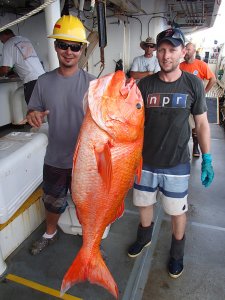


New species of Ehu, an important food fish in Hawai‘i and the Pacific Islands, named after UH biologist
April 16, 2021
(Honolulu, HI) – A new species of Ehu, or deepwater snapper, was discovered during a research study funded by the National Science Foundation and University of Hawaiʻi Sea Grant College Program (Hawai‘i Sea Grant) focusing on Ehu in Hawaiian and Pacific fisheries.
The new species was aptly named “Etelis boweni” by the research team in recognition of the contributions of Dr. Brian Bowen, a researcher at the UH School of Ocean and Earth Science and Technology’s Hawaiʻi Institute of Marine Biology (HIMB) who has spent over three decades studying marine fishes.
A new paper in the Journal of Fish Biology names the new species which looks nearly identical to the species found in Hawai‘i, but is genetically different. Both species are strikingly bright pink in color and occur at a depth of 650-1300 feet, and both are widely distributed across the Indian and Pacific Oceans.
Although they look remarkably similar, the new species grows much bigger than the other, sometimes over three feet in length. It also has smaller eyes and a black spot on the tip of its upper tail fin. Not surprisingly, some fishermen already noticed the difference. As Dr. Bowen noted, “The species is new to science, but sharp-eyed fishers have long suspected that the delicious Ehu was actually two species.”
Dr. John (Jack) Randall, a world-renowned fish taxonomist from Hawai‘i who passed away in April 2020, was part of the research team that made the important discovery. This new journal article would have added to the over 900 papers published by Dr. Randall over his lifetime. He also authored the Reef and Shore Fishes of the Hawaiian Islands, a 560-page volume published by Hawai‘i Sea Grant that he considered the culmination of his life’s work.
The international research team was led by Dr. Kim Andrews from the University of Idaho, and also included Dr. Iria Fernandez-Silva from the University of Vigo in Spain, both former postdoctoral researchers who studied under Dr. Bowen; and fish taxonomist Dr. Hans Ho from the National Museum of Marine Biology and Aquarium in Taiwan. The original suggestion for the species name came from a former PhD student of Dr. Bowen, Dr. Michelle Gaither, who is now at the University of Central Florida.
“The discovery of the new species has important implications for fisheries management, especially in areas where both species occur together, since it’s important for different species to be managed separately,” said Andrews.
Bowen has been a research scientist at HIMB since 2003 leading a highly productive research lab with over 200 peer-reviewed publications, primarily using genetics to understand the biodiversity and conservation of marine fishes.
“It is particularly fitting to name this species after Brian since he specializes in fish genetics, and it was the genetic data that led to its discovery,” said Andrews. “Brian is not only a great scientist but also a wonderful mentor and colleague, and it’s an honor to name this species after him.”
Bowen noted “It’s an honor of a lifetime. I’m sorry that the great Jack Randall didn’t live to see this completed, and humbly thank the team that described this species. It’s a handsome fish with particularly good taste.”
The University of Hawaiʻi Sea Grant College Program is part of the University of Hawai‘i at Mānoa’s prestigious School of Ocean and Earth Science and Technology. It supports an innovative program of research, education and extension services directed to the improved understanding and stewardship of coastal and marine resources of the state, region and nation. Science serving Hawai‘i and the Pacific since 1968.

